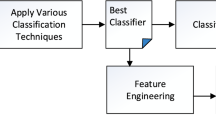Abstract
In this study, a decision support system was designed to distinguish children with ADHD from other similar children behavioral disorders such as depression, anxiety, comorbid depression and anxiety and conduct disorder based on the signs and symptoms. Accuracy of classifying with Radial basis function and multilayer neural networks were compared. Finally, the average accuracy of the networks in classification reached to 95.50% and 96.62% by multilayer and radial basis function networks respectively. Our results indicate that a decision support system, especially RBF, may be a good preliminary assistant for psychiatrists in diagnosing high risk behavioral disorders of children.




Similar content being viewed by others
References
Council for exceptional children, Report of the CEC Advocacy and Governmental relations Committee regarding the new proposed U.S Federal Definition of Serious Emotional Disturbance, Reston, VA: Author, 1991.
Sadock, B. J., Sadock, V. A., Kaplan & Sadock’s Comprehensive Textbook of Psychiatry, Vol. II., Lippincott Williams & Wilkins, 8th Edition, 2005.
Sadock, B. J., Sadock, V. A., Kaplan & Sadock’s Synopsis of Psychiatry: Behavioral Sciences/Clinical Psychiatry, 10th Edition, Lippincott Williams & Wilkins, 2007.
Agency for Health Care Policy and Research, Rockville, Diagnosis of Attention-Deficit/Hyperactivity Disorder. Summary, Technical Review: Number 3, 1999.
Harrington, R., Assessment of psychiatric disorders in children. Psychiatry 4(6):19–22, 2005.
Bruce, H., and Evans, N., Assessment of child psychiatric disorders. Psychiatry 7(6):242–245, 2008.
Pritchard, M., Observation of children in a psychiatric in-patient unit. The British Journal of Psychiatry 109:572–578, 1963.
Musisi, S., Kinyanda, E., Nakasujja, N., and Nakigudde, J., A comparison of the behavioral and emotional disorders of primary school-going orphans and non-orphans in Uganda. African Health Sciences 7(4):202–213, 2007.
Giannakopoulos, G., Kazantzi, M., Dimitrakaki, C., Tsiantis, J., Kolaitis, G., and Tountas, Y., Screening for children’s depression symptoms in Greece: The use of the children’s depression inventory in a nation-wide school-based sample. European child & adolescent psychiatry 18:485–492, 2009.
Langberg, J. M., Froehlich, T. E., Loren, R. E., Martin, J. E., and Epstein, J. N., Assessing children with ADHD in primary care settings. Expert Review of Neurotherapeutics 8:627–41, 2008.
Giedd, J. N., Castellanos, F. X., Casey, B. J., Kozuch, P., King, A. C., Hamburger, S. D., and Rapoport, J. L., Quantitative morphology of the corpus callosum in attention deficit hyperactivity disorder. The American Journal of Psychiatry 151:665–669, 1994.
Murias, M., Swanson, J. M., and Srinivasan, R., Functional connectivity of frontal cortex in healthy and ADHD children reflected in EEG coherence. Cerebral Cortex 17:1788–1799, 2007.
Özyılmaz, L., Yıldırım, T., Artificial Neural Networks for Diagnosis of Hepatitis Disease. In International Joint Conference on Neural Networks, Portland, Oregon, USA, Vol. 1, 586–589, 2003.
Zou, Y., Shen, Y., Shu, L., Wang, Y., Feng, F., Xu, K., Ou, Y., Song, Y., Zhong, Y., Wang, M., and Liu, W., Artificial neural network to assist psychiatric diagnosis. The British Journal of Psychiatry 169:64–67, 1996.
Dreyfus, G., Neural networks: an overview, neural networks methodology and applications, Springer, 497, 2005.
Schalkoff, R. J., Artificial neural networks (Mcgraw-hill International Editions: Computer Science Series). Mcgraw-hill, 1997.
Price, R. K., Spitznagel, E. L., Downey, T. J., Meyer, D. J., Risk, N. K., and el-Ghazzawy, O. G., Applying artificial neural network models to clinical decision making. Psychological Assessment 12:40–51, 2000.
Kecman, V., Learning and soft computing support vector machines, neural networks, and fuzzy logic models, A Bradford book. The MIT, Cambridge, 2001. London, England, Massachusetts Institute of Technology.
Raoufy, M. R., Vahdani, P., Alavian, S. M., Fekri, S., Eftekhari, P., Gharibzadeh, S. H., A Novel Method for Diagnosing Cirrhosis in Patients with Chronic Hepatitis B: Artificial Neural Network Approach, Journal of Medical Systems, Springer Netherlands, 2009.
Ghosh-Dastidar, S., Adeli, H., and Dadmehr, N., Principal component analysis-enhanced cosine radial basis function neural network for robust epilepsy and seizure detection. IEEE Transactions on Biomedical Engineering 55:512–51, 2008.
Pedrycz, W., Rai, R., and Zurada, J., Experience-consistent modeling for radial basis function neural networks. International Journal of Neural Systems 18:279–292, 2008.
Savitha, R., Suresh, S., and Sundararajan, N., A fully complex-valued radial basis function network and its learning algorithm. International Journal of Neural Systems 19:253–267, 2009.
Anand, P., Siva Prasad, B. V. N., and Venkateswarlu, C., Modeling and optimization of a pharmaceutical formulation system using radial basis function network. International Journal of Neural Systems 19:127–136, 2009.
Helzer, J. E., Stoltzman, R. K., Farmer, A., Brockington, I. E., Plesons, D., Singerman, B., and Works, J., Comparing the DIS with a DIS/DSM-III based physician reevaluation. In: Eaton, W. W., and Kessler, L. (Eds.), Epidemiologic Field Methods in Psychiatry: The NIMH Epidemiologic Catchment Area Program. Academic, Orlando, pp. 285–308, 1985.
Nair, J., Nair, S. S., Kashani, J. H., Reid, J. C., Mistry, S. I., and Vargas, V. G., Analysis of the symptoms of depression- A neural network approach. Psychiatry Research 87:193–201, 1999.
Bashyal, S. H., Classification of psychiatric disorders using artificial neural network. Lecture Notes in Computer Science 3498:796–800, 2005. Springer Berlin/Heidelberg.
Tai, Y., Chiu, H., Artificial Neural Network Analysis on Suicide and Self-Harm History of Taiwanese Soldiers. International Conference on Innovative Computing, Information and Control, USA, 363, 2007.
Yevseyeva, I., Miettinen, K., Räsänen, P., Decision support system for attention deficit hyperactivity disorder diagnostics, ORP3, Valencia. SeptembeR 6–10, 2005.
Vasios, C. E., Matsopoulos, G. K., Nikita K. S., Uzunoglu, N., Papabeorgiou, C., A Decision Support System for the Classification of Event-Related Potentials, 6th Seminar on Neural Network Aplications in Electrical Engineering IEEE, 2002.
Author information
Authors and Affiliations
Corresponding author
Rights and permissions
About this article
Cite this article
Delavarian, M., Towhidkhah, F., Dibajnia, P. et al. Designing a Decision Support System for Distinguishing ADHD from Similar Children Behavioral Disorders. J Med Syst 36, 1335–1343 (2012). https://doi.org/10.1007/s10916-010-9594-9
Received:
Accepted:
Published:
Issue Date:
DOI: https://doi.org/10.1007/s10916-010-9594-9




